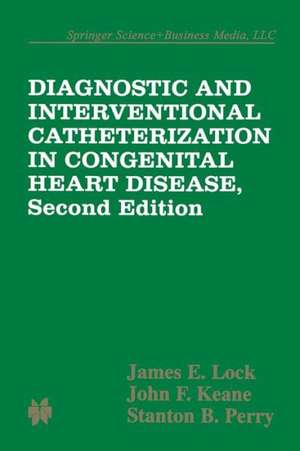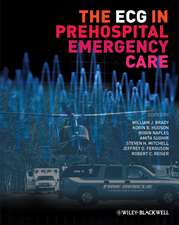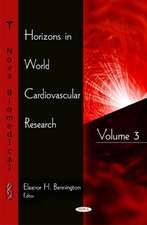Diagnostic and Interventional Catheterization in Congenital Heart Disease
Editat de James E. Locken Limba Engleză Paperback – 2 mar 2013
Since the previous edition of this book, new technologies and techniques have been introduced to the field of pediatric interventional cardiology, much has been learned about established transcatheter therapies, and there has been a substantial increase in the volume of published data on outcomes of transcatheter procedures in congenital and pediatric heart disease. With increasing experience, the role of interventional catheterization has become solidified as an integral component of the comprehensive management of patients with essentially all forms of congenital heart disease. Cardiac catheterization has also become established as a distinct subspecialty within the discipline of pediatric cardiology, and at many centers has become the purview of cardiologists who have received specialized training in interventional catheterization and whose practice is focused on catheterization. This book is targeted to trainees and established interventional cardiologists alike, and is intended as a comprehensive reference for the clinical practice of diagnostic and interventional cardiology in pediatric and congenital heart disease.
In the organization of this book, a combination of procedure-based and problem-based approaches has been employed. The structure of the book has been updated to make it more reader friendly, chapters have been added to address new techniques and problems in the field, and greater emphasis has been placed on evaluation of outcomes of transcatheter interventions in congenital heart disease.
Section 1 covers the fundamentals of cardiac catheterization, with chapters devoted to pre-procedure patient evaluation, sedation and anesthesia, vascular access and related issues, catheterization equipment ands its use, hemodynamic evaluation, angiography, radiation and radiation safety, and echocardiography in the catheterization lab.
Sections 2 through 4 include procedure-based chapters that are organized according to the technical type of intervention. Section 2 is devoted to transcatheter interventions for obstructive lesions, including valvar stenoses and vascular obstructions. Section 3 includes chapters that cover interventions to close various pathologic intracardiac communications and vascular anomalies. Section 4 includes chapters covering interventions performed to create or enlarge intracardiac communications, as well as other interventions.
Section 5 focuses on the applications of catheterization and transcatheter interventions in the evaluation and management of specific patient populations. This problem-based or patient-based focus, which is substantially expanded from the previous edition of the book, reflects the expanding role of catheterization in the comprehensive management of pediatric and congenital heart disease, and addresses emerging applications of transcatheter interventions, including management of the patient receiving extracorporeal circulatory support, hybrid transcatheter-surgical interventions, and prenatal cardiac intervention.
Section 6 includes two chapters that cover outcome assessment and regulatory issues pertinent to the pediatric cardiology in general and interventional cardiology in particular.
| Toate formatele și edițiile | Preț | Express |
|---|---|---|
| Paperback (1) | 1415.37 lei 6-8 săpt. | |
| Springer Us – 2 mar 2013 | 1415.37 lei 6-8 săpt. | |
| Hardback (1) | 1424.52 lei 6-8 săpt. | |
| Springer Us – 29 sep 1999 | 1424.52 lei 6-8 săpt. |
Preț: 1415.37 lei
Preț vechi: 1489.87 lei
-5% Nou
Puncte Express: 2123
Preț estimativ în valută:
270.82€ • 282.77$ • 224.15£
270.82€ • 282.77$ • 224.15£
Carte tipărită la comandă
Livrare economică 04-18 aprilie
Preluare comenzi: 021 569.72.76
Specificații
ISBN-13: 9781475731750
ISBN-10: 1475731752
Pagini: 400
Ilustrații: XX, 378 p.
Dimensiuni: 155 x 235 x 21 mm
Greutate: 0.56 kg
Ediția:2nd ed. 2000
Editura: Springer Us
Colecția Springer
Locul publicării:New York, NY, United States
ISBN-10: 1475731752
Pagini: 400
Ilustrații: XX, 378 p.
Dimensiuni: 155 x 235 x 21 mm
Greutate: 0.56 kg
Ediția:2nd ed. 2000
Editura: Springer Us
Colecția Springer
Locul publicării:New York, NY, United States
Public țintă
ResearchDescriere
Cardiac catheterization has long been a central diagnostic modality in the evaluation of children, adolescents, and adults with congenital heart disease, and in children with acquired heart disease. Over the past two decades, transcatheter interventions have become equally important in the treatment of pediatric and congenital heart disease. Some transcatheter therapies have become established as the standard of care for congenital cardiovascular anomalies previously managed surgically, others serve to supplement surgery in the integrated management of complex lesions, and still others are in their infancy, as pediatric interventional cardiology continues to advance in step with the broader field of pediatric cardiovascular medicine.
Since the previous edition of this book, new technologies and techniques have been introduced to the field of pediatric interventional cardiology, much has been learned about established transcatheter therapies, and there has been a substantial increase in the volume of published data on outcomes of transcatheter procedures in congenital and pediatric heart disease. With increasing experience, the role of interventional catheterization has become solidified as an integral component of the comprehensive management of patients with essentially all forms of congenital heart disease. Cardiac catheterization has also become established as a distinct subspecialty within the discipline of pediatric cardiology, and at many centers has become the purview of cardiologists who have received specialized training in interventional catheterization and whose practice is focused on catheterization. This book is targeted to trainees and established interventional cardiologists alike, and is intended as a comprehensive reference for the clinical practice of diagnostic and interventional cardiology in pediatric and congenital heart disease.
In the organization of this book, a combination of procedure-based and problem-based approaches has been employed. The structure of the book has been updated to make it more reader friendly, chapters have been added to address new techniques and problems in the field, and greater emphasis has been placed on evaluation of outcomes of transcatheter interventions in congenital heart disease.
Section 1 covers the fundamentals of cardiac catheterization, with chapters devoted to pre-procedure patient evaluation, sedation and anesthesia, vascular access and related issues, catheterization equipment ands its use, hemodynamic evaluation, angiography, radiation and radiation safety, and echocardiography in the catheterization lab.
Sections 2 through 4 include procedure-based chapters that are organized according to the technical type of intervention. Section 2 is devoted to transcatheter interventions for obstructive lesions, including valvar stenoses and vascular obstructions. Section 3 includes chapters that cover interventions to close various pathologic intracardiac communications and vascular anomalies. Section 4 includes chapters covering interventions performed to create or enlarge intracardiac communications, as well as other interventions.
Section 5 focuses on the applications of catheterization and transcatheter interventions in the evaluation and management of specific patient populations. This problem-based or patient-based focus, which is substantially expanded from the previous edition of the book, reflects the expanding role of catheterization in the comprehensive management of pediatric and congenital heart disease, and addresses emerging applications of transcatheter interventions, including management of the patient receiving extracorporeal circulatory support, hybrid transcatheter-surgical interventions, and prenatal cardiac intervention.
Section 6 includes two chapters that cover outcome assessment and regulatory issues pertinent to the pediatric cardiology in general and interventional cardiology in particular.
Since the previous edition of this book, new technologies and techniques have been introduced to the field of pediatric interventional cardiology, much has been learned about established transcatheter therapies, and there has been a substantial increase in the volume of published data on outcomes of transcatheter procedures in congenital and pediatric heart disease. With increasing experience, the role of interventional catheterization has become solidified as an integral component of the comprehensive management of patients with essentially all forms of congenital heart disease. Cardiac catheterization has also become established as a distinct subspecialty within the discipline of pediatric cardiology, and at many centers has become the purview of cardiologists who have received specialized training in interventional catheterization and whose practice is focused on catheterization. This book is targeted to trainees and established interventional cardiologists alike, and is intended as a comprehensive reference for the clinical practice of diagnostic and interventional cardiology in pediatric and congenital heart disease.
In the organization of this book, a combination of procedure-based and problem-based approaches has been employed. The structure of the book has been updated to make it more reader friendly, chapters have been added to address new techniques and problems in the field, and greater emphasis has been placed on evaluation of outcomes of transcatheter interventions in congenital heart disease.
Section 1 covers the fundamentals of cardiac catheterization, with chapters devoted to pre-procedure patient evaluation, sedation and anesthesia, vascular access and related issues, catheterization equipment ands its use, hemodynamic evaluation, angiography, radiation and radiation safety, and echocardiography in the catheterization lab.
Sections 2 through 4 include procedure-based chapters that are organized according to the technical type of intervention. Section 2 is devoted to transcatheter interventions for obstructive lesions, including valvar stenoses and vascular obstructions. Section 3 includes chapters that cover interventions to close various pathologic intracardiac communications and vascular anomalies. Section 4 includes chapters covering interventions performed to create or enlarge intracardiac communications, as well as other interventions.
Section 5 focuses on the applications of catheterization and transcatheter interventions in the evaluation and management of specific patient populations. This problem-based or patient-based focus, which is substantially expanded from the previous edition of the book, reflects the expanding role of catheterization in the comprehensive management of pediatric and congenital heart disease, and addresses emerging applications of transcatheter interventions, including management of the patient receiving extracorporeal circulatory support, hybrid transcatheter-surgical interventions, and prenatal cardiac intervention.
Section 6 includes two chapters that cover outcome assessment and regulatory issues pertinent to the pediatric cardiology in general and interventional cardiology in particular.
Cuprins
Contributing Authors. Preface. Acknowledgements. The Surgeon's Perspective; J.E. Mayer Jr. 1. Evaluation and Management Prior to Catheterization; J.E. Lock. 2. Manual Techniques of Cardiac Catheterization: Vessel Entry (Percutaneous, Cutdown, Umbilical, Transhepatic) Catheter Manipulation, Catheter and Wire Modification; S.B. Perry. 3. Hemodynamic Evaluation of Congenital Heart Disease: J.F. Keane, J.E. Lock. 4. Angiography of Congenital Heart Disease; T. Chung, P.E. Burrows. 5. Catheter Intervention: Balloon Angioplasty: Experimental Studies Technology and Methodology in Pulmonary Artery Stenosis, Coarctation, Obstructed Conduits, Stenotic Pulmonary Veins and Superior Vena Cavae, Collaterals, others); P. Moore, J.E. Lock. 6. Catheter Intervention: Balloon Valvotomy; (Technology: Methodology in Valvar Pulmonary, Aortic and Mitral Stenoses, others); S.B. Yeager, et al. 7. Defect Closure: Umbrella Devices (Technology, Methodology in Atrial Septal Defect, Ventricular Septal Defect, Fenestrated Fontan, PDA, others; A.P. Rocchini, J.E. Lock. 8. Defect Closure - Coils Embolization, (Technology, Methodology in Aorto Pulmonary and Venous Collaterals; PDA; Coronary Arteriovenous fistulae: shunts, others); J.J. Rome, S.B. Perry. 9. Stents: (Technology, Methodology in Pulmonary Artery stenoses, obstructions in homografts, veins and arteries; coarctation of Aorta, others); J. Kreutzer, S.B. Perry. 10. Other Catheterization Laboratory Techniques and Interventions: Atrial Septal Defect creation (Balloon, Blade): Biopsy, Exercise, Pericardial Drainage, Drugs, Fenestration dilation/creation, Transseptal, Others; P. Lang. 11. Catheterization of the Adult Patient with Congenital Heart Disease; M.J. Landzberg. 12. Anesthesia in the Catheterization Laboratory; P.C. Laussen, D.D. Hansen. 13. Specific Lesions &endash; How to Catheterize Tetralogy of Fallot, Pulmonary Atresia with IVS, Single Ventricle (pre and post Fontan), others; J.F. Keane. 14. Intracardiac Electrophysiologic Studies; E.P. Walsh. 15. Echocardiography in the Catheterization Laboratory; M.E. Van der Velde. 16. Index.
Textul de pe ultima copertă
Since the previous edition of this book, new technologies and techniques have been introduced to the field of pediatric interventional cardiology and much has been learned about established transcatheter therapies., The volume of published data on outcomes of transcatheter procedures in congenital and pediatric heart disease has grown and the role of interventional catheterization has become solidified as an integral component of the comprehensive management of patients with essentially all forms of congenital heart disease. This book is targeted to trainees and established interventional cardiologists alike, and is intended as a comprehensive reference for the clinical practice of diagnostic and interventional cardiology in pediatric and congenital heart disease.
Caracteristici
Expanded new edition - fifteen new chapters
Procedure and problem based approach
Reader-friendly and practical structure
Increased focus on outcomes
Procedure and problem based approach
Reader-friendly and practical structure
Increased focus on outcomes







